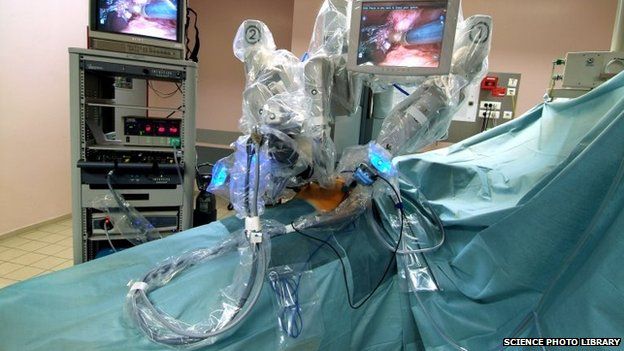

-
21 July 2015
- From the section Technology

A study into the safety of surgical robots has linked the machines’ use to at least 144 deaths and more than 1,000 injuries over a 14-year period in the US.
The events included broken instruments falling into patients’ bodies, electrical sparks causing tissue burns and system errors making surgery take longer than planned.
The report notes that the figures represent a small proportion of the total number of robotic procedures.
But it calls for fresh safety measures.
“Despite widespread adoption of robotic systems for minimally invasive surgery, a non-negligible number of technical difficulties and complications are still being experienced during procedures,” the study states.
“Adoption of advanced techniques in design and operation of robotic surgical systems may reduce these preventable incidents in the future.”
Robotic surgery can reduce the risk of infections and help patients heal more quickly.
More accidents
The work was carried out by researchers at the University of Illinois at Urbana-Champaign, the Massachusetts Institute of Technology and Chicago’s Rush University Medical Center.
Their paper says 144 deaths, 1,391 injuries and 8,061 device malfunctions were recorded out of a total of more than 1.7 million robotic procedures carried out between January 2000 and December 2013.
This was based on reports submitted by hospitals, patients, device manufacturers and others to the US Food and Drug Administration, and the study notes that the true number could be higher.
Its authors say the number of injuries and deaths per procedure has remained relatively constant since 2007. But due to the fact that the use of robotic systems is increasing “exponentially”, they add, this means that the number of accidents is increasing every year.
They highlight that when problems do occur, people are several times more likely to die if the surgery involves their heart, lungs, head and/or neck rather than gynaecological and urological procedures.
They acknowledge that the data does not pinpoint why, but suggest it is because the former are more complex types of operations for which robots are less commonly used, so there is less experience and expertise available.
The researchers did not, however, compare accident rates with similar operations in which robots were not used. Their study has not been peer reviewed.
Falling sales
Surgical robotic devices are typically expensive – costing millions of pounds – but offer advantages.
They can allow surgeons to use smaller instruments, letting them make smaller and more nimble cuts. That can mean patients recover faster, with less risk of infection and the promise of smaller scars.
In addition, the development of remote surgery means that doctors do not always need to be in the same room as their patients, allowing specialists who are in demand to treat more people.
Despite these benefits, sales of surgical robots declined by 2% in 2013 – the most recent year for which figures have been published by the International Federation of Robotics.
That has been linked to some medical experts questioning claims that the cost of using such machines is justified by improved outcomes.
“There is no good data proving that robotic hysterectomy is even as good as – let alone better – than existing, and far less costly, minimally invasive alternatives,” the American College of Obstetricians and Gynecologists said in 2013.
“Aggressive direct-to-consumer marketing of the latest medical technologies may mislead the public into believing that they are the best choice.”
Others specialists have, however, vouched for such systems’ benefits in other procedures.
“The Royal Marsden has performed more robotic surgical procedures for prostate cancer than any other hospital in the UK,” states the London hospital’s website.
“We have dramatically improved functional and oncological outcomes for patients undergoing radical prostatectomy [the removal of the prostate gland to treat cancer].”
Broken parts
Although the study links hundreds of injuries and deaths to robotic surgery, in most cases the FDA’s logs do not make clear whether the use of the machines was directly responsible.
In fact, of the headline figures, only a minority – five of the deaths and 436 of the injuries – are specifically tied to technical errors that occurred during an operation.
But the authors say there is still reason to be concerned.
They list 1,166 cases of broken/burned parts falling into patients’ bodies, which contributed to 119 injuries and one death.
Uncontrolled movements and spontaneous powering on/off of the machines are said to have caused 52 injuries and two deaths.
Electrical sparks, unintended charring and damaged accessory covers are linked to 193 injuries, including the burning of body tissues.
And the loss of quality video feeds and/or reports of system error codes are said to have contributed to a further 41 injuries and one death.
The report’s authors suggest that one way to tackle such problems would be to give surgical teams more troubleshooting training – including the use of computer simulations that feature technical problems – to help them learn how to restart surgery more quickly after interruptions.

